- Announcements
- BBQ and Food
- Cars
- Computing
- Cool Stuff
- Current Events
- Electric Vehicles
- Electronics
- Energy
- Flashahaulism
- Funny
- Government
- Hints and Tips
- History
- HVAC
- Induction heating
- Internet
- Lighting
- Misc
- Neon and other lighting
- Nuclear
- Personal
- Pets
- Philosophy
- Photography
- Power Generation
- Product Reviews
- Projects
- Q and A
- RV/Camping
- Science
- Tellico
Categories
Blogroll
 Print This Post
Print This Post
Using the Induction Heater – Process Heat
PermaLinkProcess heating is heating a material or device while that material is being processed. The process might be simple heating, melting or more complex tasks such as polymerization. While induction heating doesn’t spring to mind as the first choice in process heating – resistance heaters are usually used – it should. Resistance heating has several problems:
-
The heat must be conducted/radiated from the heater to the work and therefore the heater must be hotter than the desired process temperature. That leads to…
-
Possibility of overheating/burning the process material. This is especially the case when the heater is immersed in the process fluid.
-
The heater, having to run hotter than the process, can have its life shortened from the high heat.
-
The heater must be in intimate contact with the process material. That usually implies either immersion or a machined interface between the process and the heater.
-
The heater radiates/conducts heat in all directions. That means that for contact heating (heater in contact with the vessel) much heat is potentially wasted. This can be somewhat mitigated with heavy insulation but that makes the heater run even hotter.
Induction heating has none of these problems. Typically the work coil (the coil that carries the RF energy) is simply wrapped around the reactor/vessel and the reactor itself actually generates the heat. Insulation is still typically used to economize on energy usage but the insulation does not make the work coil get appreciably hotter.
The work coil does not have to be in intimate contact with the reactor vessel. Like with other applications of induction heating, the work coil is simply wrapped around the work (vessel) and allowed to fall where it may.
Since the work coil gets no hotter than the work itself and since it is typically much heavier gauge than the fine resistance wire involved in conventional heating, its life is indefinite. End of life would normally be from someone damaging the wire while working on the vessel.
We recently adapted Roy to provide process heat for a pilot plant reactor that is to be used to make biofuel. We were able to simulate the process with a length of steel pipe filled with sand.
This is a photo of the steel pipe wrapped with high temperature wire and connected to Roy 1.0. I was testing the basic setup. For this application I designed a special variant of Roy 2.2 to drive that many turns of work coil.
Here the steel tube is wrapped in high temperature insulation (the process temperature is approximately 350 deg C) and encased in a metal shell. Anyone who’s ever handled fiberglass insulation will understand why this is being done outdoors!
This photo shows the test setup during its first heat run using the prototype Roy. The temperature inside the steel pipe is monitored with a thermocouple and recorded on a data logger. The variac in the background adjusted the line voltage to exactly 120 volts. Our line voltage way back here in the mountains tends to run a bit low. With about 1000 watts input, this heater easily met the goal of ambient to 350 deg C within 1 hour.
Here is the custom Roy being burned in on the model. As you will notice, we’ve moved to a custom extruded aluminum case for this and future Roys.
A close-up shot of Roy 2.2E. As I mentioned before, this is a special customized version of the standard Roy 2.2E, designed for this particular heating application. We can do customized heaters for almost any application within the power capabilities of Roy. If you have such a need, contact Fluxeon® for more information.
Posted by neonjohn on October 2nd, 2010 under Cool Stuff, Induction heating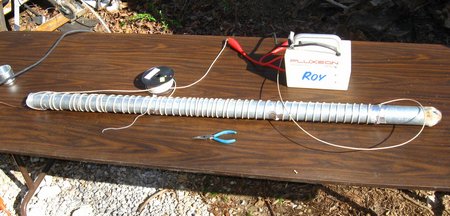
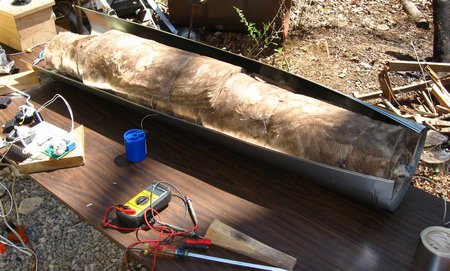
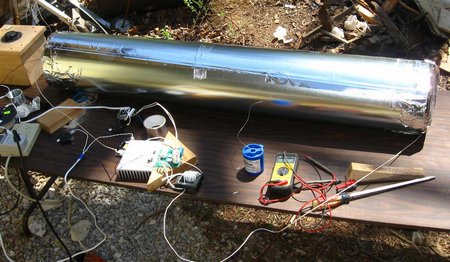
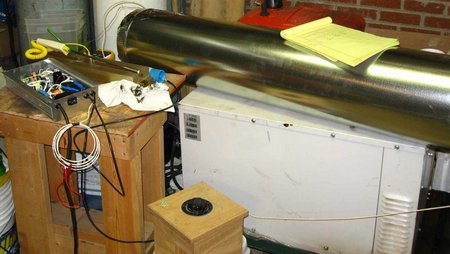
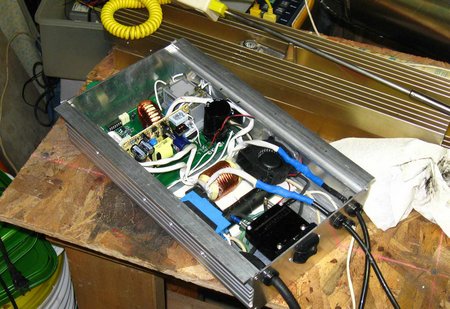
July 7th, 2011 at 4:23 am
Hi,
I am electronic engineer and worked on service industry for 20 years for repairing all kind of electronic equipments for domestic and industrial. Start learning about Induction Heating and found your company while looking to webs.
Your products and information is very interesting I feel to make one induction for hobby your web has given me a lot of ideas.
Thanks
Ashok Kumar
June 2nd, 2014 at 7:20 am
We have been using resistance heat tape, temp controlled and wrapped around a 4 foot flexible hose, to heat vasoline type products to a temp (110′) our machines can dispense into a pouch or jar.
What size unit would you recommend to wrap a 4′ section to raise product temp from ambient to 110′? Just a educated guess.
Thanks,
Bob Case
Sealpak 404-918-6095 (if you have the time)
March 4th, 2015 at 6:59 am
hello
i want make 1 kw roy induction heater but I donot muach capacity resonator c1=?
please help to me
tankyou